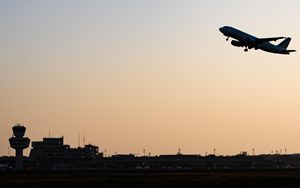(Finance) – Decarbonization represents today there central challenge for carriers and airport managers, already committed to meeting the post-pandemic global demand recovery from COVID-19 coming essentially from the sectors of tourism and manufacturing exports. Although the weight of the sector is relatively small (about 2.5%) Compared to the global share of CO2 emissions, these have increased significantly in recent years.
A first effective contribution to achieve the climate neutrality is represented by adoption of new sustainable aviation fuels (SAF), capable of contributing almost two thirds to the objective thanks to the reduction of CO2 emissions up to at 80% respect to traditional fuels. Long-term benefits may also derive from the development of new propulsion systems (electric or hydrogen) still under study. This is underlined by the new brief from the analysts of Cassa Depositi e Prestiti on the state of air transport.
An objective – we read – achievable with investments that can be activated more quickly is the transition of airport infrastructures from energy-intensive realities to real energy hubs, starting with the creation of infrastructures for the storage and distribution of sustainable fuels. Furthermore, the evolution of the airports with a view to self-production, with the implementation of photovoltaic or hydrogen systems will make it possible to satisfy the high energy needs of the assets of the airport areas and of all ground operations in a sustainable way.
I barely study it published therefore identifies some desirable lines of action in favor of the Italian air transport sector in order, on the one hand, to accompany airports towards achieving net-zero emissions objectives by 2050, and on the other to promote integrated growth both at the level of the national airport system (complementarity between airports of different sizes) and in an intermodal logic. In detail:
it is desirable, in the Italian context, to increase the level of connectivity of national airports, following the solid growth in passenger traffic, with concerted initiatives between carriers and airports that increase the quality of connections, the number of routes and their frequency. It is estimated that an increase in the connectivity index significantly impacts GDP and employment, therefore also on some strategic components such as Tourism, Export and the internationalization of the country’s economy;
strengthen Research and Development activities which will play a central role in the future prospects of sustainable fuels and new alternative propulsion systems for aircraft. The implementation of innovative digital technologies will then be important both for the so-called “core” operations (surveillance of maneuvering areas and moving vehicles, airport data management, asset maintenance) and for the efficiency of terminal-side processes that improve the passenger experience;
ensure the continuity of a favorable legislative and regulatory environment that contributes to the acceleration of green and digital investments in the air transport sector, together with a clear definition of a sector roadmap that offers certain and shared objectives towards sustainability targets; in 2022 the investments made by Italian airport managers amounted to approximately 510 million euros in total, of which almost 69 million attributable to the cornerstones of Next Generation EU, namely digitalisation, ecological transition and intermodality;
finally, the National Airport Plan (PNA)awaiting revision, could be an important tool in order to further direct the interventions of airport managers towards sustainability, digitalisation and intermodality, as part of an overall redesign of the strategic framework of the national airport system, which will have to look to the coexistence of airports of very different sizes, with different degrees of connectivity and growth prospects.
